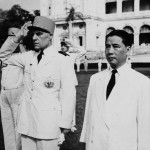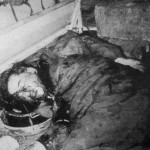
Ngo Dinh Diem (1901-63) was the American-backed leader of South Vietnam from 1954 until his overthrow and execution in November 1963. Born in the old imperial capital Hue, Diem’s family were strict Catholics and better off than most Vietnamese. His father worked in the imperial palace and for a time was in charge of housekeeping and tending royal eunuchs. Ngo Dinh Diem was a bright student who turned down a scholarship in France, choosing instead to study law at the University of Hanoi. He set his sights on a career in the public service, however, Diem’s political activism and calls for Vietnamese independence annoyed French colonial officials and brought about his dismissal. Between 1933 and the mid-1950s, Diem was effectively unemployed. He spent most of this time on his hobbies, religion and political activism. During the Japanese occupation of Vietnam (1940-45) Diem’s family was targeted by the Viet Minh, who reportedly killed his father and older brother. By 1950 Diem was forced to flee the country, having worn out his welcome with both the French and the Viet Minh.
In 1951 Diem found his way to America, where he lived for the next three years. While in the United States he engaged in what today might be called ‘networking’, establishing contacts and forming friendships with influential academics, politicians and policy advisors. Among the American powerbrokers who met Diem during this period were Secretary of State Dean Acheson and Senator John F. Kennedy. Diem also conducted a public speaking tour of New England, where he offered his perspectives on the situation in Vietnam and the policies America should adopt in south-east Asia. Diem became quite popular in America, albeit for transparent reasons. Anti-communist paranoia was still prevalent in the United States and Diem told Americans precisely what they wanted to hear. Diem was a Vietnamese nationalist who wanted to end French colonialism – but he was also a Christian who loathed communism and mouthed the rhetoric of democracy. As one Supreme Court justice crudely put it, Diem was “the kind of Asian we can live with”.

Diem returned to Vietnam in mid-1954, as the Geneva conference was drawing to a conclusion. He found South Vietnam a nation in search of a leader. The Geneva Accords confirmed Bao Dai as South Vietnam’s ‘chief of state’ – but the former emperor was little more than a figurehead who spent more time in France than his native country. The Americans pushed Diem into the spotlight as a potential leader. This surprised those with a close knowledge of Vietnam. They considered Diem a minor political figure, scarcely known in the south, despised by the Viet Minh and written off by the French as “unstable”. But Diem had three attributes that appealed to the US: he was Christian, he was vehemently anti-communist and they knew him. If Washington was to secure and stabilise South Vietnam, they needed a leader they could trust and work with. As future president Lyndon Johnson later noted, Diem was “the only boy we got out there”. In June 1954 Emperor Bao Dai appointed Ngo Dinh Diem as prime minister, at the urging of American advisors. Yet even in the United States, there was concern about Diem’s lack of experience, his fanatical Catholicism and his capacity to govern. It would not take long for these concerns to be justified.

Diem’s anti-democratic tendencies were soon exposed. He despised the Geneva Accords and had no intentions of allowing the 1956 reunification elections to proceed. Every South Vietnamese election held during Diem’s brief rule was rigged by his supporters. In the October 1954 referendum, where the Vietnamese people were asked to vote on a republican political system, Diem recorded more than 98 percent of the vote. In Saigon, he recorded more than 600,000 votes – despite the electoral roll containing only 450,000 people. Diem was also given to nepotism, appointing family members, close friends and supporters to positions of power or privilege. Two of his brothers were given control of private armies and sizeable regions, where they ruled as virtual warlords. Another brother was made ambassador to Great Britain. Still another was conferred as a Catholic archbishop. Diem’s sister-in-law’s parents were appointed ambassadors to the US and United Nations, despite having virtually no relevant experience. Together the Diem regime launched strict social reforms, which reflected their conservative Catholicism. Divorce and abortions were outlawed, while other laws cracked down on prostitution, adultery and opium use (the latter despite Diem’s younger brother Ngo Dinh Nhu being one of the richest opium dealers in the country).
“Diem is respected in Vietnam for the miracles he has wrought. Order has replaced chaos. Communism is being defeated. A pattern of leadership which could provide an alternative to neutralism in south-east Asia is being shaped and tested. To a world daunted by the idea that circumstances are bigger than men, one man with a purpose demonstrates what he calls “the power of the human personality”.
Time magazine, 1957
Despite this, Western governments hailed Diem as a hero. In 1957 he embarked on a global tour and was greeted with adulation and fanfare at almost every stop. In May Diem was welcomed to Washington D.C. by a crowd of 50,000 people; he later addressed Congress and received a standing ovation. Manhattan gave the South Vietnamese leader a ticker-tape parade; the New York mayor hailed Diem as “a man to whom freedom is the very breath of life”. Diem visited Australia in September, where the praise and ceremony surpassed that given to most foreign leaders. Diem addressed parliament and had an honorary knighthood bestowed by Australia’s prime minister, Robert Menzies. The Australian press described Diem as “incorruptible” and “one of the most remarkable men in Asia”. Diem was especially glorified by Catholic leaders, both in the US and Australia. Behind the public accolades, American foreign policy analysts kept an ever-growing file on the Diem regime and its abuses, dishonesty and corruption.
Diem’s power base began to erode in the late 1950s. In 1959 Hanoi began to refocus its efforts by seeking to remove Diem from power. The National Liberation Front (NLF) – essentially the underground communist party in South Vietnam – was formed the following year. Diem’s land reforms, rural resettlement schemes and pro-Catholic social reforms fuelled growing opposition, leading many South Vietnamese to support the NLF. By late 1960 Diem’s ‘Agroville’ project had failed and his government lost control of many rural areas. Other notable Vietnamese began to speak out against Diem, demanding greater democracy and accountability. Within the ARVN (South Vietnamese army) there were at least three groups of officers who favoured removing Diem – but they refused to support a coup while he still had the backing of the US. In April 1960 a group of nationalist politicians and intellectuals signed the ‘Caravelle manifesto‘, a document criticising Diem’s rule and demanding immediate political reform:
“The bastard regime created and protected by colonialism has been overthrown and many of the feudal organisations … were destroyed [but] the people do not know a better life or more freedom under the republican regime which you have created. A constitution has been established in form only; a National Assembly exists whose deliberations always fall into line with the government; there are anti-democratic elections. All those are methods and comedies copied from dictatorial communist regimes… Continuous arrests fill the jails and prisons to the rafters; public opinion and the press are reduced to silence… Political parties and religious sects have been eliminated… Today the people want freedom. You should, Mister President, liberalise the regime, promote democracy, guarantee civil rights, recognise the opposition so as to permit citizens to express themselves without fear… When this occurs, the people of South Vietnam will appreciate the value of true liberty and authentic democracy.”

The Caravelle demands fell on deaf ears and Diem’s nepotistic dictatorship continued. By 1963 Diem’s public image in the US and worldwide had been eroded. Reports of his corruption and brutality appeared regularly in the media. In mid-1963 Diem’s persecution of Vietnam’s Buddhists made headlines in Western countries. By late 1963 the Kennedy administration, long weary of the stream of negative press flowing out of South Vietnam, lost patience. Diem, who was always at risk of a coup d’etat from ARVN generals, had been kept safe by Washington’s backing. In August the White House sent ‘Cable 243‘, encouraging the US ambassador in South Vietnam to explore options for new leadership. Shortly after this CIA operatives provided a group of ARVN officers, led by Duong Van Minh, with $US40,000 and the go-ahead to launch an anti-Diem coup. They did so on November 1st, arresting Diem and his brother Ngo Dinh Nhu. Both were shot and bayoneted to death while being transported in a military vehicle. Few were sorry to see Diem and Nhu toppled from power, though there was widespread revulsion at their murder. There were also serious concerns that the new regime in South Vietnam might be no better.

1. Ngo Dinh Diem (1901-93) a Catholic Vietnamese politician. He was the US-backed ruler of South Vietnam between 1954 and his assassination in November 1963.
2. Diem came from an affluent family and was educated in Hanoi. He was politically minded, favouring Vietnamese independence, however, most of his adult life before 1954 was unremarkable.
3. Diem became a candidate for the leadership of South Vietnam only after obtaining the backing of the US. This was because of Diem’s ties in America and his anti-communist position.
4. Diem professed to be a democrat but his nine-year leadership was marred by nepotism, corruption and vote rigging. Despite this, he was hailed as a hero in Western countries.
5. Diem’s fall from grace began with public exposure of his corruption and brutality in South Vietnam. He killed in November 1963 after a coup led by ARVN generals and backed by the CIA and White House.
© Alpha History 2016. Content on this page may not be republished or distributed without permission. For more information please refer to our Terms of Use.
This page was written by Jennifer Llewellyn, Jim Southey and Steve Thompson. To reference this page, use the following citation:
J. Llewellyn et al, “Ngo Dinh Diem”, Alpha History, accessed [today’s date], https://alphahistory.com/vietnamwar/ngo-dinh-diem/.
